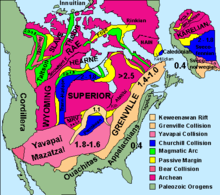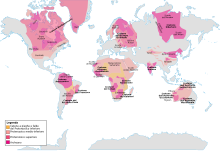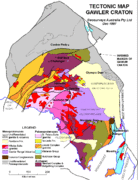Kraton

The geologically very old Precambrian core areas of the continents , which mostly consist of metamorphic rocks, are called cratons ( ancient Greek κράτος kratos , German 'force' ) ; the greenstone belts are typical .
On the other hand, the edges of the continents often consist of younger crustal parts that have been attached to the cratons in the course of the earth's history through mountain formations .
The continents' cratons are divided into two parts:
- The Precambrian shields , in which the metamorphic basement emerges
- The continental platforms where the basement is covered by unmetamorphic, unfolded, phanerozoic sediments .
Emergence
Cratons are tectonically particularly stable, which means that they do not tend to deform under tensile or compressive stress , or in other words, that they are neither prone to rift formation nor to mountain formation . This is due, among other things, to the particularly great thickness and the relatively low temperature of its subcrustal lithosphere. This lithospheric mantle keel can reach depths of 250 to 300 kilometers. Due to its chemical composition, it has a particularly high melting point. The Cratonic crust, on the other hand, has only average thicknesses of 35 to 40 kilometers.
Cratons originated mainly in the Archean related to the then higher temperatures in the mantle. The asthenosphere below cratons is usually relatively weak or nonexistent.
Classification
The cratons , which extend up to 200 kilometers into the earth's mantle - originally igneous , but mostly metamorphically shaped over time - made of relatively light rock (to the rest of the earth's crust ) can be roughly divided into the following provinces according to their age:
- Tectons : consist of rocks that were formed or last metamorphically overprinted as a result of tectonic events in the Meso- and Neoproterozoic , that is, in the period from 1.6 billion to 600 million years ago (tectonothermal age).
- Protons : are Kraton provinces with a tectonic thermal age between 1.6 and 2.5 billion years.
- Archons : are archaic "rock islands " (also called archaic nuclei ) enclosed by younger Kraton provinces with a tectonothermal age of more than 2.5 billion years, some of which even contain hadaic material (older than four billion years).
Phanerozoic evolution of the cratons
After the Proterozoic or even longer, cratons did not undergo any tectonic transformation such as folding, bulging or the like, so they have remained largely unchanged over eons . They are the cores of the continents and were mostly already intensely folded in the Precambrian by tectonic processes, metamorphically transformed or intruded and severely eroded at great depths .
Geologically, cratons are divided into shields and panels . In the shields, the crystalline basement is largely exposed, as the continental crust there has a low density and high thickness and is therefore constantly isostatically uplifted . In the table or platform regions, the shields are covered with undeformed sediments ( overburden ). As a rule, these sediments lie on the basement in a discordant manner , since the former had undergone a mountain formation and thus a phase of erosion before the table sediments were deposited . Accordingly, there is a time gap between the youngest rocks of the shield and the oldest (furthest below) rocks of the sedimentary cover. Since the crust of the basement of the tablets has a smaller thickness and a higher density than that of the shields, it has less upwelling and has therefore been covered several times by an epicontinental sea over the past 500 million years , which was ultimately the cause of the deposition of the table sediments .
Cratons have old fault zones that can be reactivated in the event of tectonic stress. For example, some cratons show active or stopped rift breaks , whereby thick layers of sediment were and are still being deposited in these trenches, and in some cases large amounts of volcanic material were brought to light.
Economical meaning
Because minerals and rocks as well as the precious metals they contain , but also various gemstones in general and diamonds in particular, tend to be separated and distributed in the earth's crust or to be melted again in the earth's mantle, the oldest cratons - since they have been Aeons of no plate tectonic changes - of the greatest interest to prospectors and mining companies . So is - especially in Canada and Australia of using measurement - paleomagnetism and gamma radiometric , sonar reflex and other stratigraphic and geochronological working methods in the discovery and exploration of this ancient continental parts of the world. The inaccessible areas of the Siberian craton and the politically troubled regions of Africa that are interesting from a mining point of view are also in the interests of the global economy. The openly exposed craton of the Baltic Shield - the Kola Peninsula - is an important supplier of raw materials to Russia . The Antarctic craton is an exception . Their remote geographical location and the harsh climatic conditions prevented the exploration of deposits for a long time . Since 1961, the Antarctic Treaty has also prevented commercial use.
List of cratons


This is a list of well-known shields and cratons as well as some of the plates , panels , basins and fractures involved in them .
- Antarctic plate
-
Australia - see also Australian plate
- Altjawarra Kraton
- Central Craton
- Curnamona Craton , South Australia
- Gawler Craton , Central South Australia
- Pilbara Kraton , Western Australia
- Yilgarn Kraton , Western Australia
-
America - see also North American Plate , South American Plate , Nazca Plate, and Pacific Plate
-
Canadian shield , also 'Laurentian shield', 'Precambrian shield' or - not quite right, because it is composed of several cratons - also North America- kraton
- Slave Kraton , Northwest Territories with the Acasta Gneiss (4030 mya )
- Superior Kraton in the south and east of Hudson Bay with the Nuvvuagittuq greenstone belt (possibly up to 4300 mya)
- Nain craton , part of the North Atlantic craton in eastern Canada and in Greenland ( Isua gneiss )
- Wyoming Kraton in the USA
- Remains of heavily embossed cratons such as the Rae craton in northern Canada
- Guiana Shield , Guiana
- Amazon basin craton
-
Canadian shield , also 'Laurentian shield', 'Precambrian shield' or - not quite right, because it is composed of several cratons - also North America- kraton
-
Africa - see also African plate and Great African Rift Valley - East African Rift
- Arabian Kraton see also Arabian Plate , to the north the Anatolian Plate , Jordan Valley
- Congo Craton and Basin, Central Southern Africa, and its Terrain
- Kaapvaal Kraton , South Africa (3,600–2,500 mya)
- Kalahari Kraton
- Sahara craton , Algeria
- Tanzania Kraton
- West Africa craton
- Zaire Kraton , Democratic Republic of the Congo
- Zimbabwe Kraton (3,500 mya)
-
Eurasia - see also Eurasian plate
-
East European Kraton with the
- Baltic shield and the
- Russian table or the
- Sarmatian Kraton (3,700-2,800 mya) Sarmatia
- Volga Ural Kraton , Russia (3,000–2,700 mya)
- Amurian plate , separated from the Eurasian plate by the Baikal rift
- Tschersky Graben in northeast Siberia at the Arctic Circle .
- Karelian craton , Finland (3,100–2,700 mya), the European part of the North Atlantic craton
- Midland Craton of England and Wales
- Siberian Kraton (Sibiria)
- Indian craton
- Dharwar Kraton , India (3,400-2,600 mya)
- East Chinacraton
- North China Crateron (2,500 mya)
- South China Crater
- Sino-Korean , Northern China
- Tarim Craton , Tarim Basin , China
- Yangtze River Kraton , China
-
East European Kraton with the
More cards
See also
literature
- Roland Walter : Earth history. The formation of the continents and oceans . de Gruyter, 2003, ISBN 3-11-017697-1 .
Web links
- Physiographic Provinces. In: National Park Service (geological topography of the United States).
- United States Geological Survey : The earth's crustal structure of China and India and the age of the last thermotectonic events on earth
- Lithospheric Studies and Global Geodynamics , Macquarie University in Australia
- The Slave Kraton from on top: The crustal view. (PDF file; 330 kB)
- scinexx.de: Scientists are researching rejuvenation and erosion in cratons
Individual evidence
- ↑ Henry N. Pollack: Cratonization and thermal evolution of the mantle. In: Earth and Planetary Science Letters. 80, 1986, pp. 175-182, doi: 10.1016 / 0012-821X (86) 90031-2 .
- ↑ Stephen F. Foley: Rejuvenation and erosion of the cratonic lithosphere. In: Nature Geoscience. 1, 2008, pp. 503-510, doi: 10.1038 / ngeo261 .
- ↑ DE James et al .: Formation and evolution of Archean cratons: insights from southern africa . In: The Early Earth: Physical, Chemical and Biological Development . London 2002.






